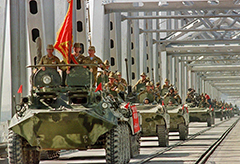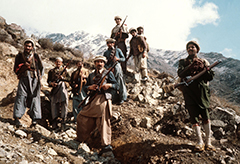The Soviet–Afghan War lasted over nine years, from December 1979 to February 1989. Insurgent groups known collectively as the mujahideen, as well as smaller Maoist groups, fought a guerrilla war against the Soviet Army and the Democratic Republic of Afghanistan government, mostly in the rural countryside. The mujahideen groups were backed primarily by the United States, Saudi Arabia, and Pakistan, making it a Cold War proxy war. Between 562,000 and 2,000,000 civilians were killed and millions of Afghans fled the country as refugees, mostly to Pakistan and Iran.
 Prior to the arrival of Soviet troops, Afghanistan's communist party took power after a 1978 coup, installing Nur Mohammad Taraki as president. The party initiated a series of radical modernization reforms throughout the country that were deeply unpopular, particularly among the more traditional rural population and the established traditional power structures. The government's Stalinist-like nature of vigorously suppressing opposition, executing thousands of political prisoners and ordering massacres against unarmed civilians, led to the rise of anti-government armed groups, and by April 1979 large parts of the country were in open rebellion.
Prior to the arrival of Soviet troops, Afghanistan's communist party took power after a 1978 coup, installing Nur Mohammad Taraki as president. The party initiated a series of radical modernization reforms throughout the country that were deeply unpopular, particularly among the more traditional rural population and the established traditional power structures. The government's Stalinist-like nature of vigorously suppressing opposition, executing thousands of political prisoners and ordering massacres against unarmed civilians, led to the rise of anti-government armed groups, and by April 1979 large parts of the country were in open rebellion.The government itself experienced in-party rivalry, and in September 1979 Taraki was murdered under orders of his rival and Minister of Foreign Affairs, Hafizullah Amin, which soured relations with the Soviet Union. Eventually the Soviet government, under leader Leonid Brezhnev, decided to deploy the 40th Army on December 24, 1979. Arriving in the capital Kabul, they staged a coup, killing president Amin and installing Soviet loyalist Babrak Karmal from a rival faction. The deployment had been variously called an "invasion" (by Western media and the rebels) or a legitimate supporting intervention (by the Soviet Union and the Afghan government) on the basis of the Brezhnev Doctrine.
 In January 1980, foreign ministers from 34 nations of the Islamic Conference adopted a resolution demanding "the immediate, urgent and unconditional withdrawal of Soviet troops" from Afghanistan, while the UN General Assembly passed a resolution protesting the Soviet intervention by a vote of 104 (for)–18 (against), with 18 abstentions and 12 members of the 152-nation Assembly absent or not participating in the vote. Afghan insurgents began to receive massive amounts of aid and military training in neighboring Pakistan and China, paid for primarily by the United States and Arab monarchies in the Persian Gulf.
In January 1980, foreign ministers from 34 nations of the Islamic Conference adopted a resolution demanding "the immediate, urgent and unconditional withdrawal of Soviet troops" from Afghanistan, while the UN General Assembly passed a resolution protesting the Soviet intervention by a vote of 104 (for)–18 (against), with 18 abstentions and 12 members of the 152-nation Assembly absent or not participating in the vote. Afghan insurgents began to receive massive amounts of aid and military training in neighboring Pakistan and China, paid for primarily by the United States and Arab monarchies in the Persian Gulf.As documented by the National Security Archive, "the Central Intelligence Agency (CIA) played a significant role in asserting U.S. influence in Afghanistan by funding military operations designed to frustrate the Soviet invasion of that country. CIA covert action worked through Pakistani intelligence services to reach Afghan rebel groups." Soviet troops occupied the cities and main arteries of communication, while the mujahideen waged guerrilla war in small groups operating in the almost 80 percent of the country that was outside government and Soviet control, almost exclusively being the rural countryside. The Soviets used their air power to deal harshly with both rebels and civilians, levelling villages to deny safe haven to the mujahideen, destroying vital irrigation ditches, and laying millions of land mines.
The military intervention was sharply and almost immediately denounced by the international community, with numerous sanctions and embargoes being imposed against the Soviet Union and the U.S.-led 1980 Summer Olympics boycott against Moscow, which was holding the event; the boycott and sanctions exacerbated Cold War tensions and enraged the Soviet government which later began and led a revenge boycott of the 1984 Olympics held in Los Angeles. The Soviets initially planned to secure towns and roads, stabilize the government under new leader Karmal, and withdraw within six months or a year. But they were met with fierce resistance from the guerillas, and were stuck in a bloody war that lasted nine years.
By the mid-1980s, the Soviet contingent was increased to 108,800 and fighting increased, but the military and diplomatic cost of the war to the USSR was high. By mid-1987 the Soviet Union, now under reformist leader Mikhail Gorbachev, announced it would start withdrawing its forces after meetings with the Afghan government. The final troop withdrawal started on May 15, 1988, and ended on February 15, 1989, leaving the government forces alone in its battle against the insurgents, which continued until 1992 when the former Soviet-backed government collapsed. Due to its length, it has sometimes been referred to as the "Soviet Union's Vietnam War" or the "Bear Trap" by the Western media. The Soviets' failure at the war is thought to be a contributing factor to the fall of the Soviet Union. More details
